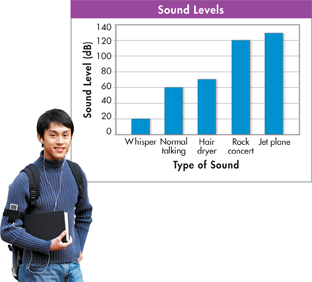Smell and Taste
 How are the senses of smell and taste similar?
How are the senses of smell and taste similar?
You may never have thought of it this way, but your senses of taste and smell actually involve the ability to detect chemicals. Chemical-sensing cells known as chemoreceptors in the nose and mouth are responsible for both of these senses.  Sensations of smell and taste are both the result of impulses sent to the brain by chemoreceptors.
Sensations of smell and taste are both the result of impulses sent to the brain by chemoreceptors.
Your sense of smell is capable of producing thousands of different sensations. In fact, much of what we commonly call the “taste” of food and drink is actually smell. To prove this to yourself, eat a few bites of food while holding your nose. You'll discover that much of the taste of food disappears until you release your nose and breathe freely.

FIGURE 31–12 Taste Buds The surface of the tongue contains many tiny projections. Taste buds line the tops of some of these and line the sides of other projections (LM 80X).
The sense organs that detect taste are the taste buds. Most of the taste buds are on the tongue, but a few are found at other locations in the mouth. The surface of the tongue is shown in Figure 31–12. Sensory cells in taste buds respond to salty, bitter, sweet, and sour foods. Recently, a fifth kind of taste sensation was identified, now called “umami,” from the Japanese word for savory. Umami receptors are strongly stimulated by monosodium glutamate (MSG), a substance often added to Asian foods to enhance their flavor. They are also stimulated by meat and cheese, which typically contain the amino acid glutamate.
 In Your Notebook Explain the relationship between smell and taste.
In Your Notebook Explain the relationship between smell and taste.
Analyzing Data
Sound Intensity
Sound intensity, or loudness, is measured in units called decibels (dB). The threshold of hearing for the human ear is 0 dB. For every 10 dB increase, the sound intensity increases ten times. Sound levels for several sound sources are shown in the bar graph.
Loud noises can permanently damage vibration-sensing cells in the cochlea. Exposure to sounds above 80 dB for several hours at a time can damage hearing. Exposure to sounds about 120 dB for even a few seconds can damage hearing.
Table of Contents
- Formulas and Equations
- Applying Formulas and Equations
- Mean, Median, and Mode
- Estimation
- Using Measurements in Calculations
- Effects of Measurement Errors
- Accuracy
- Precision
- Comparing Accuracy and Precision
- Significant Figures
- Calculating With Significant Figures
- Scientific Notation
- Calculating With Scientific Notation
- Dimensional Analysis
- Applying Dimensional Analysis






